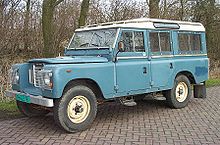Land Rover Series
Land Rover Series is the subsequently established name for a series of off-road vehicles from the British manufacturer Rover , from which the independent Land Rover brand later developed.
The first "Land-Rover" (a rover for agriculture) built from 1948 onwards was only retrospectively referred to as "Series I" in 1958 , when "Series II" was introduced; From 1971 the "Series III" followed .
The successor was the Land Rover Defender , which was only introduced in 1983 as the "Land Rover 90" and "Land Rover 110". Until the introduction of the name Defender, the types 90 and 110 were called "Ninety" and "One-ten" in the English pronunciation of the numbers. Until the introduction of the Defender, Land Rovers were simply named after their wheelbase and the series (series I - IV).
Series
Series I (1948-1958)
First came the 80 " wheelbase with a 1.6-liter gasoline engine. The headlights had a diameter of 5" and were located behind the radiator grille (Lights behind the grill). The next 80 "got 7" headlights that peeked through round holes through the radiator grille (“Lights through the grill”) with a drilled 2-liter engine, followed by a real 2-liter gasoline engine. This already had a "T-Grill" in which the 7 "lamps no longer touched the grill. In 1953 the model series was extended to an 86" wheelbase and a 107 "pickup was added. To make room for the diesel engine , the wheelbase of the models has been extended by 2 "to 88" and 109 "respectively.
Since the “Land” Rover was originally developed for use in agriculture, it had power take- offs (PTOs) on the drive train . Land Rover specifies five possible locations for the Land Rover series at which internal and external devices such as compressors , generators or log splitters can be driven. These can be found on the engine and transmission. In the framework, cutouts were taken into account for the transmission waves required if necessary. The switching of the ancillary units was possible outside or in the passenger compartment or both, depending on the device. In the case of the common capstan winches, for example, the control was carried out directly on the winch and the power take-off at the front of the motor. Equipment that was driven via the gearbox had a connection in the vehicle.
Series II and II A (1958–1971)
The Series II and II A were built from 1958 to 1971. There was some overlap in the early Series II. The already existing parts of Series I were installed. E.g. in the Land Rover 88, the old 2l engine of the series I.
Changes compared to Series I:
- Body higher, wider and rounder.
- Engine with more displacement and power
- new door hinges
- slimmer rocker panels
From 1967, in addition to the 2286 cm³ four-cylinder petrol and diesel engines, there was also a 2625 cm³ six-cylinder petrol engine, which tends to cause problems in extreme conditions.
The manual transmissions have synchronizing rings in third and fourth gear. This means that double coupled when shifting from first to second gear must and when downshifting in the second or first gear declutching is necessary. With the introduction of the IIa series, a synchronized gearbox was offered and installed especially on the 109.
With the beginning of the year of construction 1968, the headlights were no longer installed directly next to the grill, but, as in the later Series III, in the front fenders.
Series III (1971-1984)
The third series was also offered with two center distances with the external dimensions unchanged compared to series II and IIa:
- 88 "(2235 mm) (SWB), length 3617 mm, width 1676 mm, height 1969 mm on wheels 6.0 R16
- 109 "(2769 mm) (LWB), length 4445 mm, width 1676 mm, height 2057 mm on wheels 7.5 R16
In addition to the designs already known from Series II / IIA, the 109 HCPU (High Capacity Pickup) was offered from 1981 to 1984 with a 25% larger load volume and a larger payload than the normal pickup.
In the course of the production time, the vehicles were gradually converted to metric and the four-cylinder engines were stored five times.
Changes compared to Series II / IIA:
- Plastic dashboard
- Mirrors on the doors
- Fully synchronized gearbox as standard
- Plastic grille
- Headlights in the front fender (as with the last series IIA models)
- Stronger Salisbury rear axle as standard on the 109
In addition to a 2.25-l four-cylinder diesel engine with 63 PS (46 kW), three petrol engines were offered: 2.25-l four-cylinder with 73 PS (54 kW), 2.6-l OHV six-cylinder with 86 PS ( 64 kW) and a 3.5-liter V8 engine with 91 hp (68 kW).


